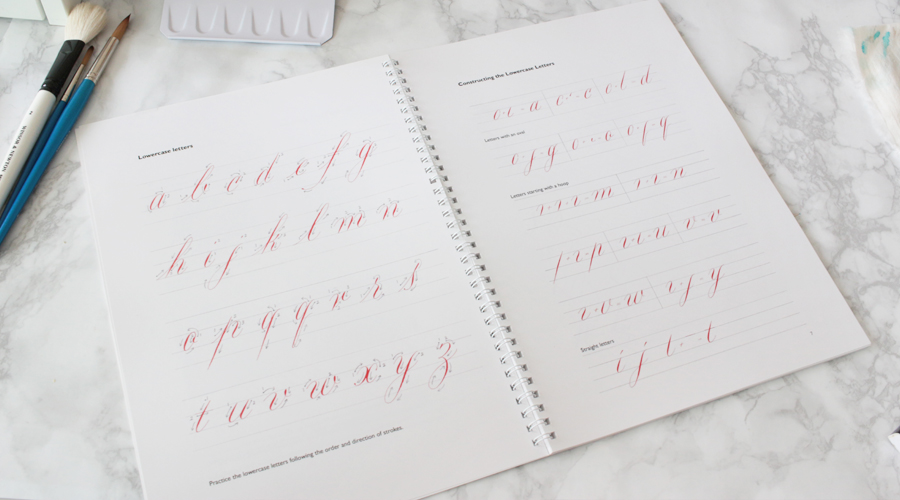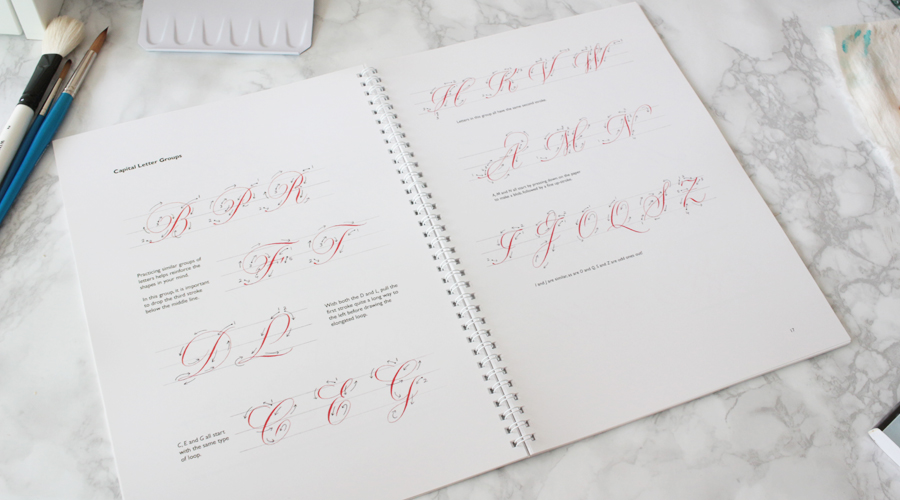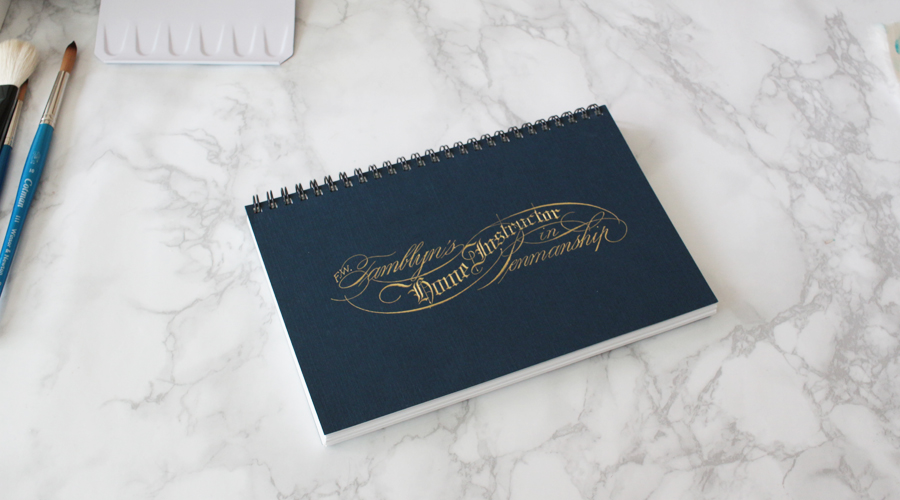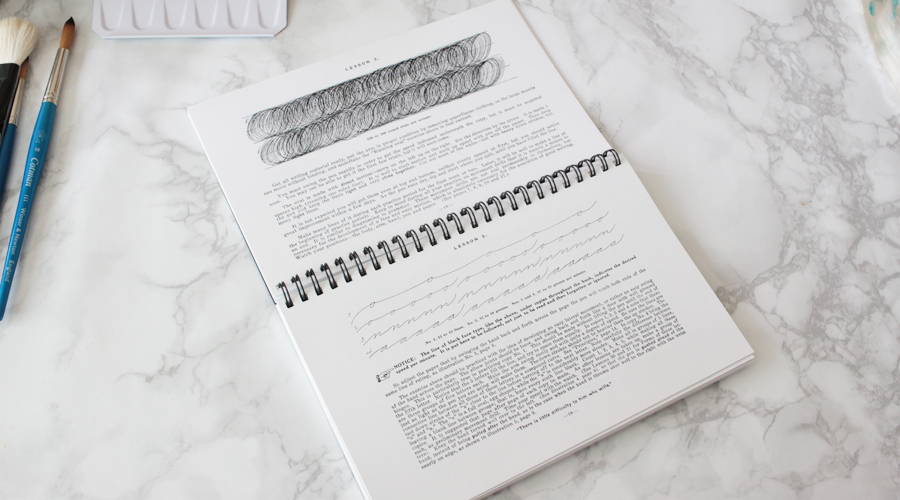
Copperplate calligraphy is probably one of the most difficult styles of calligraphy to get into, because the information available is pretty much scattered all over the place. It’s also difficult because there are different styles of copperplate calligraphy, as well as variations within those different styles so it’s easy to get overwhelmed as a beginner. Another frustration is that while for square edged nib calligraphy the book Foundations of Calligraphy by Sheila Waters is widely recommended by teachers, there isn’t one definitive book for copperplate. The good news is that there are some great resources and communities online for learning copperplate calligraphy, so if you have the will there is a way!
The first thing you want to know is that there are two major types of pointed pen calligraphy. The first is commonly referred to as Copperplate, and the second is called Spencerian. Copperplate developed in the UK and Spencerian developed in the US. The styles are pretty different and you can see examples in this article by Dr. Joseph Vitolo. The second thing you need to know are the different terms of Copperplate. I really recommend that you read through Dr. Joseph Vitolo’s article, but here are the cliff notes:
#. English Round Hand – This is the style that developed in the UK that is seen in the book The Universal Penman by George Bickham.
#. Engrosser’s / Engraver’s Script – This style developed in the US by metal engraver’s that were engraving with the English Round Hand style. Engrosser’s also started using English Round Hand for engrossing documents like graduation diplomas. The biggest difference from the English Round Hand is that the Engrosser’s/Engraver’s script wasn’t a form of handwriting but a way of engraving things in metal and engrossing diplomas. Another term you’ll commonly hear is the “Zanerian style.” This is a type of Engrosser’s script by Zaner who founded the Zanerian College of Penmanship, that is seen in The Zanerian Manual.
You can see a comparison of the English Round Hand and Engrosser’s script in this post. They’re pretty similar but if you take a closer look they’re stylistically different. So I think it’s a matter of personal preference as to whether you decide to practice the English Round Hand or Engrosser’s script. Now that we’ve got the technical terms sorted out, let’s take a look at the books:


The Universal Penman is basically a historical source book that is full of examples by the best English Round Hand examples of the day. This makes this book a valuable resource, but unfortunately it doesn’t have any instructions on how to actually write this way. This creates a dilemma because this book has beautiful examples of the English Round Hand that you’re trying to achieve, but as a complete beginner it will get you no where.
At this point I wandered through three other books. Mastering Copperplate Calligraphy by Eleanor Winters, Copperplate Calligraphy by Dick Jackson, and The Technique of Copperplate Calligraphy by Gordon Turner. However, these modern step by step books seemed to be un-recommended without a whole lot of explanation other than the fact that they weren’t stylistically pleasing. This seemed a bit baffling to me until I spent more time observing and learning within the calligraphy community. Dr. Joseph Vitolo emphasizes here the importance of starting from a good exemplar, and Paul Antonio always emphasizes the importance of going back to the historical source.



The Zanerian Manual is recommended by Dr. Joseph Vitolo as the best book for learning Copperplate in the Engrosser’s style. This first seven pages of this book is crammed full of specific instructions on how to write Engrosser’s script. The rest of the book is filled with source material of various scripts and layouts.



A Simple Copperplate Manual by Rachel Yallop was recommended by Paul Antonio, and I’ve found it to be one of the clearest, most helpful books on Copperplate calligraphy. Her style is different from English Round Hand and Engrosser’s script as she learned from a French calligrapher, but her work is very beautiful and her instructions are clear and concise. Not only does her manual show the order of the strokes, but she also shows how each letter is constructed and how groups of letters have similar construction. I find it extremely helpful how she breaks down the letters into different parts and how she shows similar letters side by side because it makes it so much easier to wrap your head around and see the bigger picture. Another helpful feature of her manual is that the letters are in red and the guidelines are in black so there is no confusion as to which line is part of the letter and which line is just the guideline. All of the other Copperplate manuals are in black and white which creates for some confusion. Her manual also explains how letters are joined together, how spacing works, and how to add flourishes.
#. Other Resources
Now that I’ve covered the books on Copperplate, I want to introduce some other resources that I’ve found to be very helpful. First of all, Paul Antonio has tons of informative videos on youtube and vimeo that go over some of the fundamentals of learning calligraphy. He also shares his work on instagram and does live video on the Periscope app @PAScribe. The Iampeth website is a nightmare to navigate, but once you get used to it you’ll find so many resources there! The also have a collection of rare books that you can download as a pdf (in the black interface click on the ‘i’ in the top right corner, choose pdf, wait for it to load, then hover your screen at the top for the drop down menu to appear and click on the arrow pointing down that is next to the printer icon). Nina @anintran and Kei @kei.haniya also have really helpful tutorials on instagram and periscope so definitely follow them! Both Nina and Kei are so kind and always willing to answer questions about learning calligraphy.


This last book isn’t exactly a manual for Copperplate but I thought I’d throw this in here. I saw @thefozzybook using this on instagram to do practice drills and wanted one for myself. F.W. Tamblyn’s Home Instructor in Penmanship is chock full of drills and practice lessons. It’s always fun to look through @thefozzybook‘s feed and look at the drills she’s done. I should also mention that both Nina and Kei also emphasize the importance of drills and sometimes explain how to do drills on periscope as well.
Your Turn ♥ What type of calligraphy are you most interested in?



